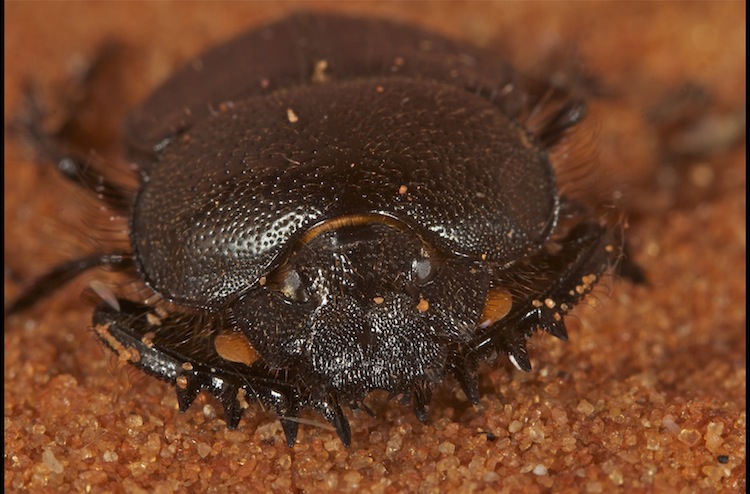Page 182 of 295
Re: Insect or Invertebrates Identification
Posted: Wed Mar 18, 2020 4:54 pm
by Klipspringer
Re: Insect or Invertebrates Identification
Posted: Wed Mar 18, 2020 4:57 pm
by ExFmem
Re: Insect or Invertebrates Identification
Posted: Wed Mar 18, 2020 5:00 pm
by Klipspringer
Scarabaeus satyrus, uses light from the Milky Way to orient itself.
And it looks very much like this species, fits into the distribution, is reported from KTP. And there are not many nocturnal species in that area.
What do you think?
Re: Insect or Invertebrates Identification
Posted: Wed Mar 18, 2020 5:02 pm
by ExFmem
Let me read further, and will get back. Sounds VERY intriguing!
Re: Insect or Invertebrates Identification
Posted: Wed Mar 18, 2020 5:59 pm
by Klipspringer
DungBeetleMAP — Atlas of Dung Beetles in southern Africa.
31 species found for Kgalagadi Transfrontier Park
these are the spp listed there
Catharsius melancholicus 1 1 1990-02-15
Cheironitis audens 1 1 1990-03-27
Euonthophagus flavimargo 2 2 1988-04-07
Gymnopleurus asperrimus 2 3 1994-01-18
Gymnopleurus humanus 2 2 1994-01-18
Gymnopleurus humeralis 1 1 1990-03-27
Metacatharsius anderseni 1 4 1988-12-22
Metacatharsius dentinum 2 3 1990-03-27
Metacatharsius exiguiformis 3 6 1990-03-27
Metacatharsius marani 4 6 1988-01-23
Onthophagus acutus 2 5 1990-03-28
Onthophagus bicavifrons 1 1 1990-03-28
Onthophagus convexus 2 5 1990-03-27
Onthophagus granulifer 1 3 1988-04-07
Onthophagus pallidipennis 2 2 1990-03-27
Onthophagus probus 2 3 1990-03-27
Onthophagus rubens 1 1 1988-02-17
Onthophagus semiflavus 1 3 1990-03-27
Onthophagus signatus 4 12 1997-11-20
Phalops rufosignatus 1 2 1990-03-27
Phalops wittei 1 3 1990-03-27
Pycnopanelus krikkeni 2 3 1990-03-27
Sarophorus costatus 1 1 1983-03-15
Scarabaeus anderseni 1 1 1990-02-15
Scarabaeus flavicornis 1 1 1980-01-07
Scarabaeus kalaharicus 2 3 2006-11-02
Scarabaeus parvulus 2 3 1990-02-15
Scarabaeus proboscideus 5 8 1990-03-27
Scarabaeus satyrus 3 4 1990-03-28
Sisyphus gazanus 1 1 1985-03-15
S. satyrus and S. flavicornis are nocturnal
Otherwise they look more or less alike.
Re: Insect or Invertebrates Identification
Posted: Wed Mar 18, 2020 6:12 pm
by Klipspringer
Re: Insect or Invertebrates Identification
Posted: Wed Mar 18, 2020 11:57 pm
by ExFmem
Re: Which dung beetle?

KTP
As you said, they are both from that area, and are nocturnal. Which one, I don't know. Perhaps my photo doesn't show angles/features to distinguish the two. S. flav. looks to be more "punctuated/indented", like mine, but that may be a very variable characteristic.


Also, if one "zoomed in", S.satyrus would also show more "punctuations". ?
Maybe write it up as S. species, possibly S.satyrus or S.flavicornis???
I see they used S.satyrus in the Milky Way study, but I suppose, being nocturnal it also applies to S. flav.? What a really cool study!


Thanks so much for bringing it to my, and everyone's attention.

Maybe I'll post a brief synopsis of the findings in the Interesting or Unusual Behavior Topic tomorrow.

Re: Insect or Invertebrates Identification
Posted: Thu Mar 19, 2020 10:19 am
by Klipspringer
The pinned specimen are sometimes missleading, because of colours and hairs
So I did another search on inaturalist and am now convinced that it is S. flavicornis, S. satyrus is rather bare on the face and pronotum
https://www.inaturalist.org/taxa/688371 ... wse_photos
another dead one, but still hairy
https://www.inaturalist.org/taxa/549131 ... wse_photos
This one matches perfectly ExFmem's, I think
Re: Insect or Invertebrates Identification
Posted: Thu Mar 19, 2020 10:36 am
by Lisbeth
Re: Insect or Invertebrates Identification
Posted: Thu Mar 19, 2020 3:58 pm
by Klipspringer
Amazing when you see the details. The "hairs" on the front legs are used for combing the eyes and antennae.
The lateral body hairs must have a purpose, too

don't know, but maybe to keep out the soil and sand, otherwise it might enter the body cavity

The 4 teeth on the legs are for digging - these guys are rollers and must dig burrows for the brood balls.






